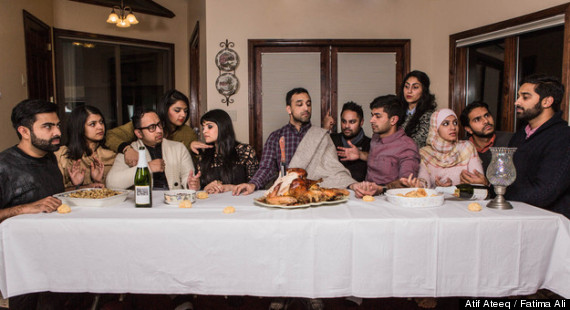by Christine Sine
I love images that help us understand the Jesus story from the perspective of different cultures. The image above for instance, though depicting a Native American Jesus was actually painted by John Guiliani, an Italian.
Several years ago I came across another interesting photo from the Huffington post article Muslim “Last Supper” Photo Offers Interfaith Tribute to Da Vinci’s Masterpiece. It made me think even more deeply about the face of Jesus and how, not just we but people of other cultures and faiths see him.

Last Supper – Fatimah Ali
The organizer Fatima Ali commented:
“For this year’s photo, we wanted to do something that, in its own humble way, aimed to bridge the gap between Eastern and Western cultural and religious norms. We looked up the painting, assigned each person a character, and meticulously tried to mimic the image, while also making it our own.”
The pictured group enjoyed the process of putting a different spin on the the iconic artwork. “Most of the people pictured in this photo have been active members of the Islamic Center at NYU, and I think one of the greatest values we all have shared is this overwhelming sense of community and religious unity,” Ali said. “I don’t mean just Muslim unity or Muslim community, I mean on a more universal level, being respectful and considerate of all faiths and religious communities.”
Not surprisingly, the photo elicited a varied response from Christians. Some are delighted by this depiction of Christ and his followers with faces that look more authentic than the white faces we usually see. Others are appalled by Muslims depicting what they view as a sacred Christian event.
Why am I posting a photo of the Last Supper you may ask when we are getting ready to celebrate the birth of Christ? Arn’t I getting to the end of the story before we have seen the beginning? No. In so many ways this photo epitomizes Christmas. When I first posted this, also in the Christmas season, I added a quote from Monastery Journey to Christmas by Brother Victor-Antoine D’Avila-Latourrette. He writes: Jesus is the Prince of Peace whose face the whole world longs to see. I think that in the hearts of all humankind there is indeed a deep ache for the coming of a saviour. More than that there is a deep ache to see the face of Jesus in the faces and actions of his followers, and in the faces of all who long for peace where there is violence, abundance where there is starvation and healing where there is disease.

Nativity Varghese – Malaysia
As I look out at my seemingly dead Seattle garden, wet and soggy after another storm, I can fully appreciate this. Winter seems to have destroyed all life, yet hidden in the earth, the roots still live, growing stronger, reaching deeper ready to emerge in the coming spring. For the Jewish people there was a long winter of centuries before Jesse’s Root, sprouted forth with the coming of Christ, the Messiah. For us there have been even more centuries of longing, of hoping and of anticipation.

Madona – Saincilus Ismael
When Christ first appeared he was like the first sprouts of spring growth – weak, vulnerable, tiny compared to the tree that would grow. This is the Christ whose remembrance we celebrate at Christmas. Yet in that tiny shoot lay the hope and promise of what was and still is to come – a tree that could spread over all the earth, a saviour for the whole world whose power and scope is far greater than any of us could ever imagine. This is the Christ for whose coming we wait with joyful anticipation. This is the Christ whose tree has already spread across the whole earth, yet we still see so much of the darkness that it is meant to overcome. We still wait in anticipation for the full unveiling of this Christ who fills our hearts with longing for the future in which all things will be made new. In the meantime it is wonderful to catch glimpses of it in the depiction of Christ’s birth from many cultures.

Nativity – Lu Lan China 1994
I love what Brueggemann says about the coming of Christ
There was something unreal about him: no pretense, no ambition, no limousine no army, no coercion, no royal marking. Wise and intelligent people are turned toward the regal. Kings and prophets want to penetrate the mystery. But the Jesus who showed up amid royal hopes and royal songs was of another ilk, powerful in weakness, rich in poverty, wise in foolishness, confounding the wisdom of the Greeks and bewildering the Jews.
He is beyond all usual categories of power, because he embodies the gentle, gracious, resilient, demanding power of God. He does not trifle in temples and cities and dynasties but in the power and truth of the creator God.
This tender shoot, this vulnerable child whose very birth reveals the upside down nature of God’s kingdom is an ensign for the nations, a flag towards which all people will be drawn and that includes the Muslims and people of other faiths. The word we translate as “nations” had a very different meaning for the Jews. “Gentiles” were everyone who was not Jewish. It encompassed all peoples outside Israel, opening God’s promise of salvation to all cultures and countries. The new kingdom Christ ushered in is open to the entire world. Christ the Messiah, the tiny Branch which is slowly becoming a mighty tree will break down walls and barriers between all people.
What Is Your Response?
I love this children’s depiction of the birth of Jesus. It is fun, but also I think there are things that we can learn as we listen to children tell the story. Watch it prayerfully. What stands out for you? Is there something new that strikes you about the story of the birth of Christ?
